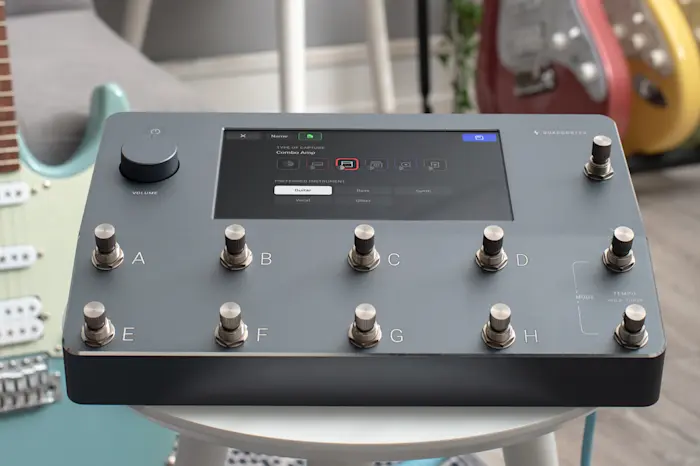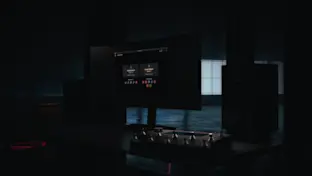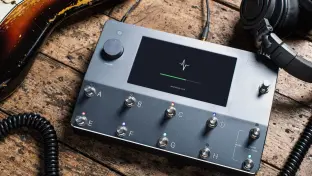
Quad Cortex Development Update #26

Formerly Quad Cortex Development Update - July 2022
Managing files is about to get a whole lot easier.
As we find ourselves closer to completing development for CorOS 2.0.0, we wanted to share our progress on the redesigned file manager and its associated features to prepare you for some of the many upcoming changes.
Please note the images below may not be final and are subject to change.
UI
With hundreds of Presets, Neural Captures, and IRs, organizing files on Quad Cortex has become a challenge for many users. We’ve implemented several changes to help search, filter, and categorize items to make it quicker and easier to find what you’re looking for.
Presets, Neural Captures, and IRs are now broken into separate categories in the Directory, and each category can easily be collapsed or expanded on the left-hand side. The banks column has been shrunk to allow the right column to be bigger to accommodate new buttons for uploading and to make longer filenames easier to read.

Each category has separate folders for Downloads, Cloud items, Factory items, and My items.
Downloads: Items you have downloaded or to be downloaded.
Cloud items: Items you have uploaded to Cortex Cloud.
Factory items: Items that came with Quad Cortex that cannot be deleted.
My items: Items you have stored on Quad Cortex.
The swipe left to edit functionality has been removed from items in the Directory and replaced with a contextual menu button that reveals editing functionality.

A contextual menu has also been added to Setlists allowing you to edit or delete them.
When saving an item, the editor UI has changed to make use of more of the screen. The blue button at the top-right takes you to the next step where it is possible to add additional metadata. You can also tap the file location box to change the save location, or tap the metadata icon next to the name to move forward to the metadata page.

Tags have been removed from the save UI on Quad Cortex, but can still be added to items on Cortex Cloud/Mobile.
After adding a name, you can specify a preferred instrument for your Preset.

This metadata can be used when searching/sorting on Quad Cortex and on Cortex Cloud/Mobile.
When scrolling to the top or bottom of a bank of Presets, the next bank shows above/below so you can continue scrolling, and the bank automatically changes in the middle column.

Neural Captures and Presets
We have made several changes for sorting and organizing Neural Captures.
Banks have been removed from Neural Captures and replaced with a more robust sorting & filtering system, as well as the brand new Search.

When saving a Neural Capture, two new types of metadata have been added: Capture Type and Preferred Instrument.

The complete list of Capture types includes Default, Amp Head, Amp + Cab, Combo Amp, Cab, and Pedal. Each Capture type has its own icon, and this icon will display on The Grid when the Capture type has been set.
It is also possible to add this metadata when editing a Preset on Quad Cortex or on Cortex Cloud/Mobile.
Captures can be filtered by the range of Capture types.

Sorting options have been added to the Directory as well. Neural Captures can be sorted by Name, Date added, Author, Preferred instrument, Capture type, and Gain. You can tap an option a second time to change between ascending and descending order.

Gain is a metadata automatically calculated by Quad Cortex when creating a Neural Capture. Quad Cortex analyzes the sound produced by a Neural Capture and determines how saturated it is, giving it a ranking of 1-10; 1 being a clean tone and 10 being the most saturated/highest distortion.
All existing Neural Captures on Cortex Cloud will be automatically updated to have this metadata calculated when CorOS 2.0.0 is released.
When sorting, the Reference box allows you to change the information displayed in the list of sorted results.

The default information that displays changes based on the category and folder you have selected, but in the example above, the Neural Capture downloads have been referenced by gain and sorted by Capture type.
Tapping a Capture in the Directory immediately displays The Grid and shows all of the available spaces where the Capture can be added.

Furthermore, two arrows will display above any block that you can switch with the selected Neural Capture. The arrows will only display above blocks where there is enough CPU available to switch the devices.
Like with Captures, Presets can be sorted. “Banks” is now a sort option, so if you sort by anything else, your Presets will display in a list rather than in banks.

Impulse Responses
Banks have also been removed from Impulse Responses, and instead they are displayed in a long list with sorting options.

IRs with long names have the middle of their names truncated so that the beginning and end of the filename is visible, making them easier to read.
Uploading & Downloading
The interactions with Cortex Cloud have undergone some significant changes, and several quality-of-life improvements have been made.
When uploading Presets or Neural Captures, instead of dragging-and-dropping each item to the top of the screen, you now toggle Upload Mode with the button at the top-left.

With Upload Mode toggled, simply tap the Upload button next to each item and it will upload in the background. Press the Upload Mode button again to exit. Items will continue to upload in the background even when you’ve exited Upload Mode.
We’ve removed the Starring system completely, and instead items can just be downloaded.

Once you have added items to your download queue on Cortex Cloud/Mobile, when you open a Downloads folder and your Quad Cortex is connected to Wi-Fi, the items will begin downloading immediately.
Once Presets have downloaded, they live in your Downloads folder until they are either moved to a Setlist or deleted.

If you would like to move a Preset from your Downloads folder to a Setlist, tap the Save & Move button. From here you can browse your Setlists (or create a new one) and choose where you would like to save the Preset. Once saved, you will be taken back to the Downloads folder.
Presets can be auditioned directly from the Downloads folder; just tap a Preset to load it onto The Grid.

The Downloads folder can be sorted like other folders.

Downloading and managing Neural Captures works very similarly to Presets, however tapping the Save & Move button will simply move the Neural Capture to the My Captures folder, since there are no banks or Setlists to manage for Neural Captures.

Additionally, the Downloads folder icons will change to a Wi-Fi Disconnected icon if Quad Cortex is not connected to Wi-F. Of course, you can continue to use items that have already been downloaded in your Downloads folder when Quad Cortex is offline.
Search
Search has been completely overhauled. Search now spans the entire screen. Recently searched terms are displayed beneath the text entry.

Search displays suggestions beneath the text entry as you type.

Search results are separated into categories & tabs for Presets, Neural Captures, and IRs. There are also subcategories for each of the locations where files can be found, and these can be collapsed or expanded by tapping the arrows on the right-hand side.

Tapping an item will take you to the file’s location in the Directory and highlight it. From there you can interact with the item, continue browsing the Directory, or tap the Search button to return to the search results.
Search results can be sorted & filtered (depending on the category selected), and all the relevant metadata is available to reference as required.

More to come
The redesigned filemanager is one of several features in CorOS 2.0.0, but certainly our most significant change so far. We’re excited to share more details with you soon, and hopefully have the update available to download in not too long.
If you would like to discuss these changes, please head over to our forum or Discord.
Thank you.
Francisco Cresp

